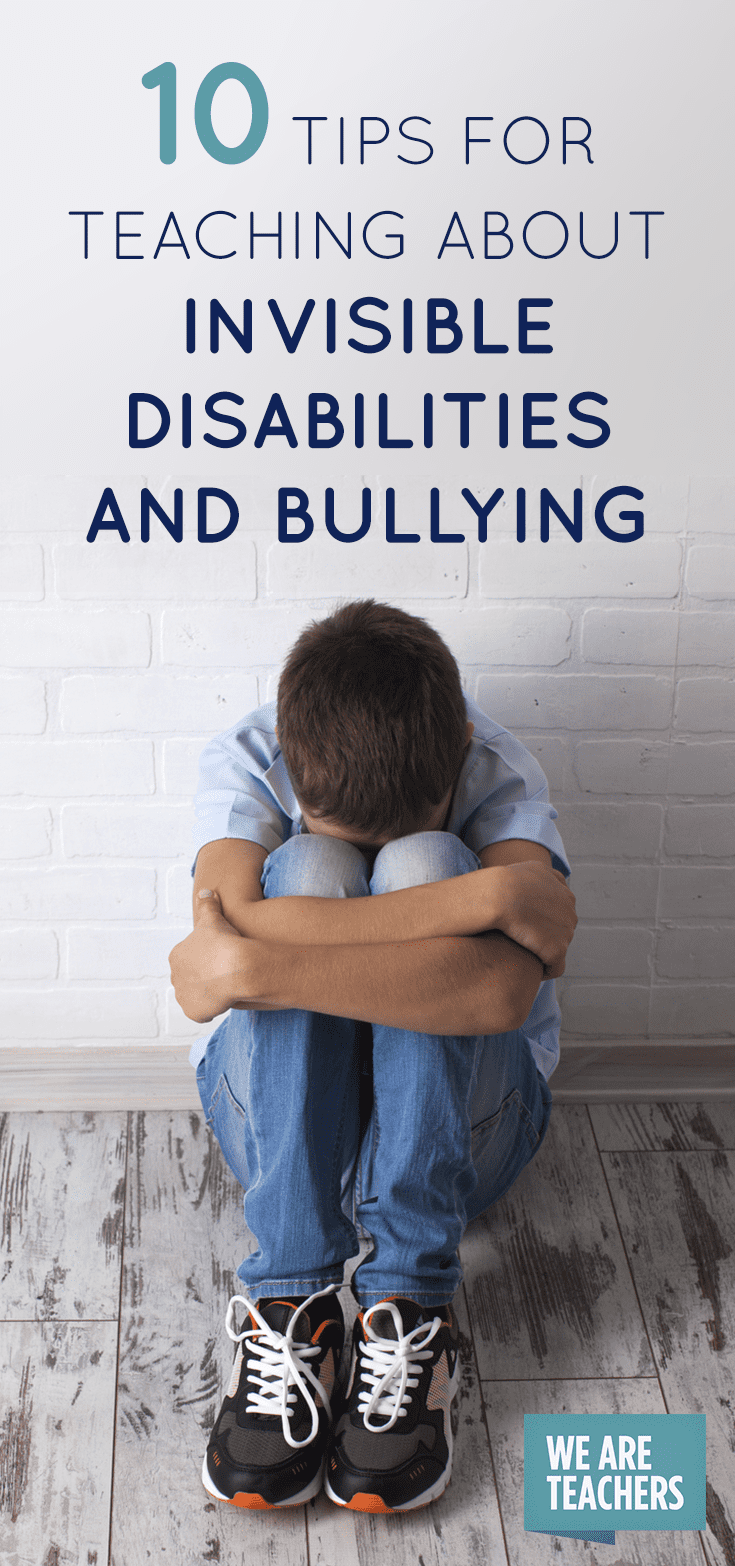Did you know that children with disabilities are more likely to be bullied than other children—some studies say as much as two or three times more likely? And students with so-called “invisible” or hidden disabilities—such as dyslexia, hearing loss, allergies, anxiety, ADHD, speech impairments, and autism spectrum disorder—are particularly vulnerable.
Why? When a child’s differences are not surface-level, such as a wheelchair, for example, other students may not have the emotional IQ to understand them. “Generally, kids want to be friends with kids they can identify with and who are alike,” says Jennifer Heithaus, fellow in developmental pediatrics at Saint Louis University School of Medicine in St. Louis, Missouri. “Anybody that doesn’t really fit that mold sticks out, gets isolated,” and may become bullied, she says.
Here’s the good news: We can play a critical role in bullying prevention by encouraging a culture of acceptance through discussion and classroom activities. Here are some ideas from experts about how to handle these issues in the classroom.
Highlight students’ uniqueness. “Sometimes you can see individuals’ differences and sometimes you can’t,” says Anjali Forber-Pratt, assistant professor in the department of human and organizational development at Vanderbilt University in Nashville. Be explicit about this with kids, and discuss the strengths and challenges that we all have. She suggests asking kids: “What is it that helps you succeed or do well?” Then talk about how some kids have glasses to help them see, hearing aids to hear better, or some need to have their name called to focus on directions.
Explain the spectrum of disabilities. Talk about the range of disabilities—in ways that are age appropriate. For example, ask elementary-school-age children: “What is a disability?” They will often mention someone with a physical disability. Then, explain there are disabilities that we can’t see that can affect our behavior or mood. Stress it’s not the student’s choice to act a certain way, but it’s the way their mind or body responds.If kids are given basic, honest information, they are often quite understanding and helpful to their classmates, says Leanne Sargent-Suarez, a resource specialist at LOGAN Community Resources, which serves individuals with developmental disabilities in South Bend, Indiana. For instance, if a student asks why child with autism spectrum disorder puts his hands over his ears in a loud lunchroom, she suggests explaining that the child’s hearing works really well and something that might not seem loud to everyone is loud to him. “Say that each person’s individual body works a little different and that’s just them taking care of the differences they have,” says Sargent-Suarez. “Fairness is giving what each individual student needs, not exactly the same thing.”
Be open and comfortable. Sometimes adults shy away from talking about disabilities because they don’t want to say the wrong thing or hurt anyone’s feelings, says Forber-Pratt. Plus, teachers have to balance issues of student privacy. But kids are naturally curious and teachers should create a comfortable space in which to talk and ask questions about disabilities. “Not acknowledging [the disability] is making it more taboo for the child,” says Sargent-Suarez. Talk in general terms and be positive, without zeroing in on the child.
Discuss appropriate language. Emphasize the individual over the label with person-first language, such as a “person with a disability” rather than a “disabled person.” Be clear that certain words are unacceptable, such as retard, spaz or lame, and explain why. “It’s important to talk about how our language has changed over the years,” says Sargent-Suarez. “Words can affect us and words can affect each other.” Retard means delayed, but when used in a derogatory way, it can be hurtful.
Create clear ground rules. Be positive and emphasize what is expected of children—including what bystanders can do in a bullying situation. Suggest helpful phrases for kids who want to intervene to say such as, “This isn’t OK” or “I can be your friend,” suggests Sargent-Suarez. At regular classroom meetings, share examples of students who have been helpful to others in class. Do some role-playing to model interactions you’d like to see in class. Something as simple as encouraging students to be friendly to a child with a disability or ask him or her to play with at recess can create an inclusive atmosphere.
Address bullying directly. If you see bullying happening in your school or classroom, experts recommend facing it head-on. “Talk to students, making what’s unsaid said,” says Heithaus, who works with schools on programs to improve the social integration of students with disabilities. “Acknowledge the issue, without picking out specific students, and recognize there is a problem.” Studies have shown that it’s helpful to kids who are struggling with bullying to know a supportive adult is aware and available to speak in private about any problems.
Work on community. Take time to let students get to know one another. At the beginning of the day, invite children to share what’s happening at home and with their families. Look for common ground between students who have hidden disabilities and those who do not. Understanding one another creates a caring, inclusive environment where bullying is less likely. While these class meetings begin with specific lesson plans to discuss bullying and communication, curricula like Olweus More Class Meetings That Matter recognize that they often end up building class cohesion, community, and conflict resolution skills.
Invite students and parents to share. Sometimes parents may want to visit a class to read a book about differences and answer questions about their child’s disability. Other times, students may want to self-advocate and be the “expert” with a show-and-tell about their disability, says Forber-Pratt. In some instances, you may want to couple that with a chance to ask questions without the student present. The key is talking to the family in an IEP planning meeting to gauge how they would like the topic to be addressed in the classroom, if at all.
Look for opportunities for socializing. Kids who suffer from bullying are often excluded. Heithaus suggests finding ways outside the classroom for students with disabilities to get involved with others through school teams, music groups or other extracurricular activities. Forber-Pratt adds that it’s important to be intentional about welcoming students with meeting locations that are accessible, videos with captions and other efforts to be open. “You want to send the message, ‘Hey, we really do want you to join this club or team,’” she says.
Expose kids to adults with disabilities. When assigning a biography or hero project, be sure to include famous people that students might not know have a hidden disability—as well as those with physical disabilities, suggests Forber-Pratt. Invite people with disabilities to be guest speakers. Bring in community members or athletes with various disabilities to talk about their lives and field questions. “It’s a safe zone for kids to ask absolutely anything they want to—and they will, which is awesome!” she says.
All of these tips for teaching students about invisible disabilities and bullying can be found in the Olweus Bullying Prevention Program’s More Class Meetings That Matter. Register to win an entire Olweus Prevention Pack for your classroom worth $331.85!



